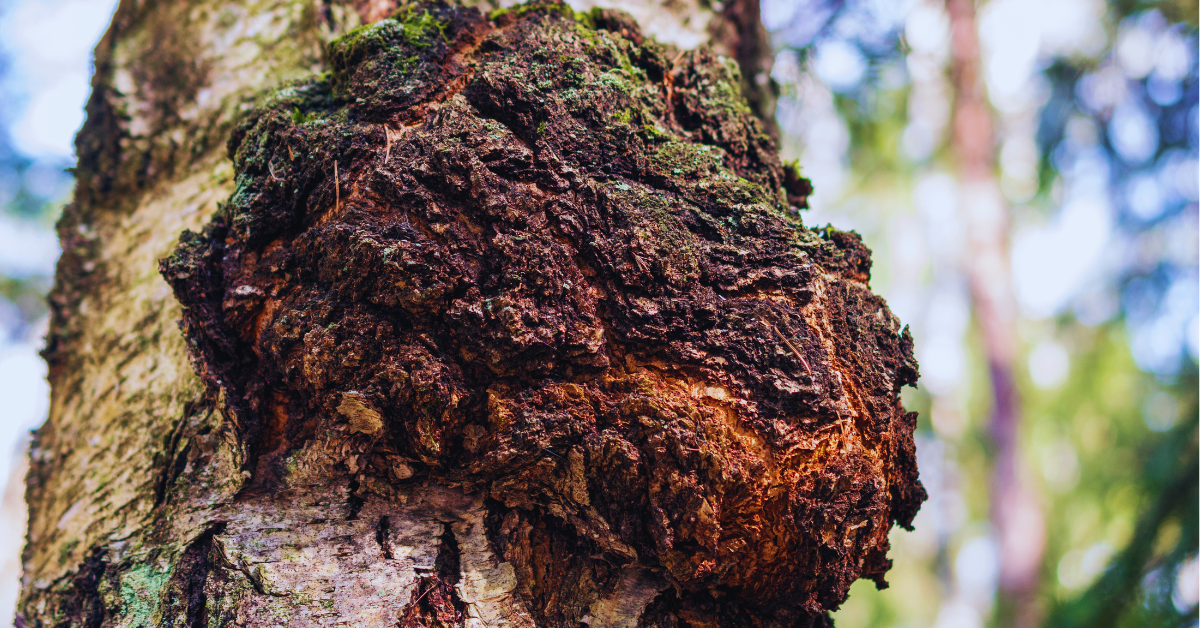Your cart is empty

Chaga Mushrooms: The Nutrient-Dense Fungus
What Are Chaga Mushrooms?
Chaga mushrooms (Inonotus obliquus) are a type of fungus that grows primarily on birch trees in colder northern climates. These wild mushrooms have a very distinct appearance, forming large black charcoal-like growths on infected trees.
Despite their unappealing exterior, chaga mushrooms have been used in traditional folk medicine for centuries, especially among Slavic and Siberian cultures. More recently, modern research has been undertaken to better understand chaga's numerous reported health benefits.
Some key identifying traits and facts about the chaga mushroom are:
- Grows mainly on birch trees in Northern Europe, Asia, and some northern parts of North America
- Multi-year growth results in a black irregularly-shaped sclerotium that looks similar to charcoal
- One of the best natural sources of antioxidants
- Contains a range of beneficial polysaccharides, phenolics, and triterpenes
The chaga conk is the part of the mushroom with the highest concentration of bioactive compounds and nutrients. Traditional use involves chopping the woody sclerotium into smaller pieces for long-term extraction.
When prepared as a tea or tincture, chaga mushrooms offer a complex nutrient profile that early scientific findings have linked to anti-inflammatory, antiviral and anticancer properties.
Keep reading to uncover more about chaga mushrooms like their unique growing habits, history of use, nutrient composition, and preparation as a supplement.
Where Chaga Mushrooms Grow
In the wild, chaga mushrooms primarily grow on birch trees located in cold, northern climates. The fungus infects wounds and scars on birch trees, slowly forming black charcoal-like hard growths called sclerotia over the span of 5-7 years.
Chaga requires specific conditions to proliferate in nature:
- Cold climates with average temperatures around 0-20°C
- Grow mostly on birch trees (Betula genus)
- Infected wounds or cracks in the bark are entry points for the fungus
- Mature sclerotium can reach 10-20 inches across
- Grow at higher latitudes and altitudes
- Found in northern Asia, throughout Siberia, Eastern and Northern Europe, Northern Canada, Alaska
Russia and Eastern European countries such as Finland, Poland, and the Baltics have especially high amounts of wild chaga. Russia is the world’s top producer of wild chaga mushrooms.
Trying to find chaga mushrooms growing can be difficult due to their preference for higher altitude old-growth forests. Chaga used for supplements and tea is wildcrafted by experienced hunters or ethically farmed to meet rising demand.
Traditional and Modern Uses
Chaga mushrooms have an extensive history of use in traditional folk medicine, especially among Northern Asian and Eastern European cultures where chaga prolifically grows wild.
Some traditional uses of chaga include:
- Russia/Siberia - Topical poultices and tea used as early cancer treatments
- Finland - Buckwheat flour and chaga baked into breads
- Poland - Modern clinical trials based on traditional chaga liquors
- Korea - Anti-inflammatory use for digestive issues like ulcers
In these regions, chaga is revered as a potent medicinal mushroom. Siberians referred to it as the “Gift from God” and the “Mushroom of Immortality” for its perceived health benefits.
"The medicinal mushroom Chaga, Inonotus obliquus, has been used in folk medicine in Russia, Poland, and most of the Baltic countries, as a cleansing and disinfecting measure, and as decoctions for stomach diseases, intestinal worms, liver and heart ailments, and cancer treatment." — Marta Kinga Lemieszek
The author highlights how chaga was traditionally used as an antibacterial to support gut health and fight inflammation. Its rise in popularity is due to renewed interest in functional mushrooms and preventative Eastern medicine.
In recent years as more research emerges and information spreads, chaga mushrooms have rapidly increased in popularity worldwide. You can now readily find chaga supplements and extracts promoting gut health, immune defense, and antioxidant activity.
Potential Health Benefits of Chaga
Modern science is working to validate some of the traditional health claims surrounding the chaga mushroom. Early research shows promise for the following potential benefits:
Potent Antioxidant Activity
- High levels of melanin and polyphenols
- Superior ORAC score compared to common antioxidants
- May help fight free radical damage and oxidative stress
Anti-Inflammatory Effects
- Anti-inflammatory polysaccharides like beta-glucans
- Reduced inflammation markers IL-6 and CRP in studies
- Applied topically for skin inflammatory conditions
Possible Anticancer Properties
- Antitumor effects shown in lab studies
- May boost immune system to fight cancer cells
- Clinical research limited to small trials so far
Antiviral & Antibacterial Activity
- Traditional use for gut health and fighting infections
- May protect against flu and viruses like H. pylori
- Requires more high-quality clinical trials

While preliminary research on chaga shows promise, higher quality human trials are still needed to back up some health claims. Most existing studies note more research is warranted.
However, chaga remains a nutrient-dense choice known for its anticancer history and as a beneficial antioxidant source even if modern trials are still ongoing.
Nutrient and Compound Profile
Chaga mushrooms contain a complex composition of beneficial nutrients, minerals, and bioactive compounds:
Polysaccharides
- Contain beta-glucans, a type of polysaccharide with immune and gut health benefits
- Chitin and heteroglycans also present
Phenolic Compounds
- High concentration of phenols, like quinic acid, gallic acid, catechins
- Contribute to antioxidant capacity
Oxalates
- Oxalic acid content varies from 10-80mg/g depending on source
- Moderate consumption recommended for those prone to kidney stones
Triterpenes
- Anti-inflammatory and anticancer triterpenes like betulin, betulinic acid
- Up to 5% of the biomass by dry weight
Melanin
- Big contributor to antioxidant activity
- Gives the black exterior color
This unique nutrient profile is what produces the antioxidant, antiviral, anti-inflammatory and other effects often attributed to chaga mushrooms. Using the whole mushroom provides the full spectrum of beneficial compounds.
Sourcing and Preparing Chaga
Sourcing Chaga
When searching for a chaga supplement, quality matters. Here are some tips on finding a reputable source:
- Choose wild-harvested chaga from northern climates like Canada, Siberia, Finland
- Ensure sustainable harvesting that does not harm the trees
- Consider certified organic chaga products
- Research the supplement brand for transparency and testing
Preparation Methods
To release the beneficial nutrients and compounds from the tough, woody chaga sclerotia, proper processing techniques should be used:
- Chop/grind into small pieces to increase surface area
- Hot water extraction via decoction for beverages like tea
- Cold extraction in an alcohol tincture over several weeks
- Hot water extraction into a dried powder or extract paste
Popular Forms of Prepared Chaga
Common ways to consume chaga mushrooms include:
- Chaga tea - The most traditional preparation method
- Chaga tinctures - Alcohol extraction as drops or spray
- Chaga powder - For adding to foods, drinks or encapsulating
- Dual extracts - Combines hot water and alcohol extraction

No matter the form, preparing chaga using either hot water, alcohol or both is necessary to draw out the beneficial compounds locked inside this medicinal fungus.
Potential Side Effects and Safety
Chaga mushrooms have a generally positive safety profile but do come with some precautions:
- May interact with anticoagulant or antiplatelet drugs
- Contraindicated for those with bleeding disorders
- Possible allergic reaction if sensitive to other fungi
- Kidney stone risk at high doses due to oxalate content
- Lacks human trials to establish safe dosages
- Pregnancy and breastfeeding safety unknown
Recommended dosages vary widely but studies showing benefits use anywhere from 300mg to 1800mg taken 1-3 times per day. It’s best to start low then increase slowly.
Look for supplements tested for purity and potency. Talk to your doctor before taking chaga mushrooms if on medication or currently struggling with a health condition, as interactions may occur.
While generally well-tolerated when usage instructions are followed, be cautious of potential side effects. As with increasing intake of any new supplement, monitor your body’s response.
Frequently Asked Questions
What does chaga mushroom taste like?
Chaga has a mild, earthy flavor profile. When infused into teas or tinctures, it takes on subtle vanilla, cinnamon, and woody birch tree undertones.
Where can I buy chaga?
Chaga mushroom products like powders, teas, and extracts can be found at health food stores or online shops specializing in medicinal fungi. Always verify sourcing and quality before purchasing.
Is chaga safe to consume daily?
At moderate dosages, daily usage of pure chaga mushroom supplements appears safe for most people. However, consult your doctor if on medications or pregnant/nursing before adding it to your routine.
What is the best way to prepare chaga mushroom tea?
Traditionally, chaga is simmered for hours to extract the bioactive compounds. Grind whole chaga into small chunks before decocting the pieces for at least one hour to make the most nutritious tea. Add vanilla or spices to improve flavor.
Writer: Carrie H. Carrie is a dedicated health and nutrition writer with a strong background in medical and scientific research. She is driven by a passion for helping others lead healthier lives, diving into the latest scientific research. Combining evidence-based knowledge with practical advice, Carrie strives to provide accurate and valuable information on health, nutrition, and wellness. Her ultimate aim is to empower readers, enabling them to make informed choices about their well-being. |
Reviewed By: Dr. Kevin Huffman Dr. Kevin D. Huffman, D.O., is a leading board-certified bariatric physician with extensive expertise in treating obesity. He has trained countless healthcare providers and founded American Bariatric Consultants to develop protocols and training materials sought by medical societies, pharmaceutical companies, patients, and hospitals. Dr. Huffman's impact extends beyond patient care as he prepares physicians for board certification, expanding access to this vital treatment. |
- Choosing a selection results in a full page refresh.











